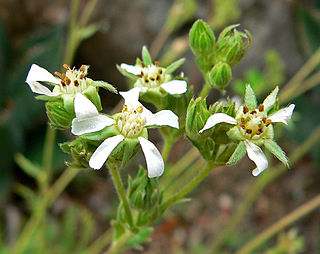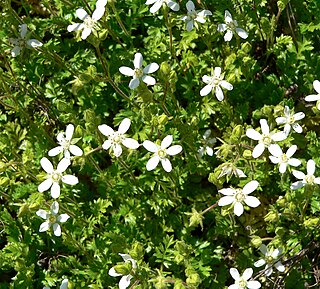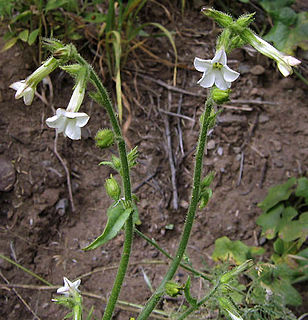Horkelia bolanderi is a rare species of flowering plant in the family Rosaceae. It is endemic to northern California where it is known from only a few occurrences in two or three counties. It grows in the mountain forests of the North Coast Ranges. This is a mat-forming gray-green perennial herb producing hairy erect stems 10 to 30 centimeters tall. The leaves are 3 to 8 centimeters long and are made up of hairy, toothed leaflets each one half to one centimeter long. The inflorescence holds several flowers, each with five white petals and up to 20 pistils in the center.

Horkelia californica, known by the common name California horkelia, is a species of flowering plant in the rose family.

Horkelia clevelandii is a species of flowering plant in the rose family known by the common name Cleveland's horkelia. It is native to the Peninsular Ranges of southern California and northern Baja California. This is a perennial herb forming clumps of long, fernlike leaves and erect stems. The leaves are up to 18 centimeters long and are made up of triangular to rounded leaflets, each toothed or lobed and covered in thin hairs. The narrow stems reach 10 to 50 centimeters in height and bear inflorescences of several flowers. Each flower has hairy, lance-shaped bractlets and pointed sepals. The narrow oval petals are white. The center of the flower contains ten stamens and up to 50 pistils.

Horkelia daucifolia is a species of flowering plant in the rose family known by the common name carrotleaf horkelia. It is native to the Klamath Mountains and surrounding ranges in northern California and southern Oregon, where it grows in mountain slopes and fields, often on serpentine soils. This is a perennial herb producing a rosette of leaves each five to 15 centimeters long. Each leaf is made up of lobed, hairy leaflets each one or two centimeters long. The plant produces erect stems up to 30 centimeters tall and bright red or greenish in color. The inflorescence holds several flowers, each with narrow, pointed bractlets and wider, reflexed green or pinkish sepals. The five narrow petals are white, yellow, or pink.

Horkelia fusca is a species of flowering plant in the rose family known by several common names, including pinewoods horkelia and dusky horkelia. It is native to the western United States from California to Wyoming, where it is generally found in mountain forests and meadows. This perennial herb forms a thick tuft of leaves, each growing erect up to 15 centimeters tall. Each leaf is made up of wedge-shaped or rounded leaflets with toothed or lobed edges. These are often gray-green and somewhat hairy. The brown or reddish hairy stem reaches a maximum height near 60 centimeters and holds an inflorescence of several clusters of flowers. Each flower has small, pointed bractlets beneath larger green, red, or magenta sepals and five white to pinkish petals. The center of the flower has a ring of ten stamens around a bunch of 10 to 20 small pistils.

Horkelia marinensis is a rare species of flowering plant in the rose family known by the common name Point Reyes horkelia. It is endemic to the California coastline, where it is known from about Fort Bragg to near Santa Cruz. It grows on beaches and in other sandy coastal areas. This is a perennial herb growing in low, dense patches. The leaves are up to 10 centimeters long and are made up of toothed, hairy, gray-green leaflets each around a centimeter long. The foliage is glandular and strongly scented. The plant produces green to reddish-green stems up to 30 centimeters long which bear inflorescences of dense clustered flowers. Each flower has minute bractlets under reddish-green, fuzzy sepals. The petals are generally white and narrow with rounded ends. The center of the flower contains a ring of stamens around a patch of 20 to 30 pistils.

Horkelia parryi is a species of flowering plant in the rose family known by the common name Parry's horkelia. It is endemic to California, where it grows in the chaparral of the Sierra Nevada foothills. This is a low, mat-forming perennial herb growing in unobtrusive green patches on the ground. The leaves are 5 to 10 centimeters long and are each made up of small, toothed, oval-shaped leaflets. The somewhat hairy green to reddish-green stems are 10 to 30 centimeters long and bear inflorescences of a few flowers each. The flower has minute bractlets under larger, pointed sepals and five white petals. The center of the flower contains a ring of stamens around a patch of up to 50 thready pistils.
Horkelia sericata is a species of flowering plant in the rose family known by the common names silky horkelia and Howell's horkelia. It is native to the Klamath Mountains of northern California and southern Oregon, where it grows in the chaparral and forest, often on serpentine soils. This is a perennial herb growing in small tufts of erect leaves and stems. The leaves are 3 to 15 centimeters long and are each made up of herringbonelike rows of small, tightly packed leaflets. The green leaflets bear long, silky white hairs, giving the plant a silvery green look. The green, brown, or reddish stems reach up to 50 centimeters long and bear loose inflorescences of many flowers. The flower has small green sepals covered in luxuriant white hairs, and white or pink-tinted petals with two-lobed tips.
Horkelia tridentata is a species of flowering plant in the rose family known by the common name threetooth horkelia. It is native to all of the mountain ranges of northern California and southern Oregon, where it grows in coniferous forest. This is a perennial herb forming tufts of erect leaves and stems. The leaves are 3 to 12 centimeters long, each made up of hairy gray-green leaflets which are tipped with usually three teeth. Unlike many other horkelias, this species is generally not strongly scented. The green or reddish stems reach a maximum length of about 40 centimeters and hold clusters of flowers. Each flower has minute bractlets beneath small, hairy, pointed sepals and narrow white petals.
Horkelia truncata is a species of flowering plant in the rose family known by the common name Ramona horkelia. It is native to the Peninsular Ranges of southern California and northern Baja California, where it grows in the chaparral. This is a clumpy perennial herb forming tufts of erect leaves and stems. The leaves are up to 13 centimeters long and are made up of large oval-shaped leaflets with toothed edges and squared-off, toothed tips. The terminal leaflet of the leaf is sometimes untoothed. The thin stem is 20 to 60 centimeters tall and holds an inflorescence of several flowers. Each flower has short sepals beneath five round white petals. The center of the flower contains a ring of stamens around a patch of up to 80 thready pistils.
Horkelia tularensis is a species of flowering plant in the rose family known by the common name Kern Plateau horkelia. It is endemic to Tulare County, California, where it is known from about ten occurrences in the High Sierra Nevada. It grows in rocky, exposed areas.
Ivesia muirii is a species of flowering plant in the rose family known by the common name granite mousetail. It is endemic to the High Sierra Nevada of California, where it grows on rocky slopes and cliffs.

Delphinium bicolour is a species of larkspur known as little larkspur and low larkspur. It is native to northwestern North America from British Columbia to South Dakota, where it grows in mountain forests and foothill scrub and prairie. This is a perennial herb growing from a thickly branching root system. It produces solitary stems to 40 centimeters in height and green with reddish bases. Most of the leaves are low on the stem and grow on short petioles. They are several centimeters long with many rounded lobes. The small inflorescence holds several flowers. The flower has dark purple-blue sepals each about 2 centimeters long and a spur of 1 to 2 centimeters. The plant is poisonous to cattle, less so to sheep, and it is occasionally eaten by various species of wild cervids.

Horkelia hendersonii is a rare species of flowering plant in the rose family known by the common name Henderson's horkelia. It is known from four populations in southern Oregon, including Mount Ashland, and one population south of the border in Siskiyou County, California. It is a resident of dry forest habitat in the granite soils of the Klamath Mountains. This is a perennial herb producing a low mat of hairy, glandular gray-green foliage about a woody base. The leaves are cylindrical and sometimes tapering to a point, growing erect in a patch around the caudex. Each leaf is 3 to 8 centimeters long and is made up of densely spaced pairs of minutely toothed leaflets. The leaflets are coated in silky hairs. The inflorescence is a dense array flowers atop an erect stalk, each flower made up of five hairy, pointed sepals and five smaller, more delicate white petals.

Horkelia hispidula is a species of flowering plant in the rose family known by the common name White Mountains horkelia. It is endemic to the White Mountains, a small mountain range that straddles the border between California and Nevada east of the Sierra Nevada. It is a resident of dry scrub and alpine and subalpine forest habitat. This is a perennial herb producing a low mat of hairy, glandular greenish gray foliage about a woody base. The leaves are cylindrical and sometimes taper to a point, growing erect in a patch around the caudex. Each leaf is up to 10 centimeters long and is made up of crowded pairs of hairy leaflets. The inflorescence is an array of up to 15 flowers atop an erect stalk, each flower made up of five hairy, pointed, reflexed sepals and five white petals.
Horkelia wilderae is a rare species of flowering plant in the rose family known by the common name Barton Flats horkelia. It is endemic to San Bernardino County, California, where it is known from only about ten occurrences in the vicinity of Barton Flats. It grows in the montane chaparral and woodlands habitat where chaparral meets pine forest, and it is threatened by logging.
Horkelia yadonii is a rare species of flowering plant in the rose family known by the common name Santa Lucia horkelia. It is endemic to California, where it is known from the Central Coast Ranges from Monterey to Santa Barbara Counties. It occupies chaparral and woodland habitat, often in meadows and dry riverbeds. Easily confused with related species, this plant was not recognized as a species of its own until 1993. This is a perennial herb producing hairy, glandular, gray-green mat of erect leaves around a caudex. Each leaf is up to 20 centimeters long and is made up of several pairs of wedge-shaped to rounded leaflets with lobed to deeply notched tips. The inflorescence is an open array of 5 to 10 flowers atop a tall, erect stalk, each flower made up of five pointed, green sepals and five white petals

Nicotiana clevelandii is a species of wild tobacco known by the common name Cleveland's tobacco.

Stellaria obtusa is a species of flowering plant in the family Caryophyllaceae known by the common names Rocky Mountain chickweed, blunt-sepaled starwort, and obtuse starwort. It is native to western North America, from British Columbia and Alberta to California to Colorado, where it grows in moist areas in forests and on mountain slopes.
Stellaria umbellata is a species of flowering plant in the family Caryophyllaceae known by the common names umbrella starwort and umbellate starwort. It is native to western North America from Alaska and northwestern Canada to the southwestern United States, as well as parts of Asia, including Siberia. It grows in subalpine and alpine climates in mountain forests and riverbanks. It is a rhizomatous perennial herb producing a slender prostrate stem up to about 20 centimeters long, sometimes forming clumps or mats. The stem is lined with pairs of oval leaves each up to about 2 centimeters long. The inflorescence is an umbel-shaped array of several flowers each on an arching or erect pedicels. The flower has five pointed green sepals each no more than 3 millimeters long. There are occasionally tiny white petals within the calyx of sepals, but these are generally absent.












